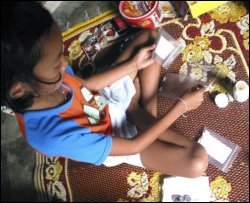But Enormous Challenges Remain

With the counseling and guidance given by the MSF home-based care team, this 11-year-old girl can manage to prepare the drugs for herself without the assistance of her mother. Prachomklao province, Thailand. Photo © Joanne Wong/MSF
Rio de Janeiro/Geneva, 27 July 2005 – Doctors Without Borders/Médecins Sans Frontières (MSF) is successfully treating an increasing number of children living with HIV/AIDS, according to data from MSF treatment programs presented at a "late breaker" session at the 3rd International AIDS Society Conference in Rio de Janeiro. MSF's clinical outcomes are good despite the fact that currently available diagnostic tests and medicines are poorly adapted for children.
"We are committed to treating more children, even if no easy-to-use medicines designed for this purpose exist yet and we have to improvise solutions," said Dr. Pierre Humblet, coordinator of MSF's international AIDS team. "Although clinical results presented in Rio are encouraging, in order to massively increase access to treatment for children, new or improved diagnostic and monitoring tests and treatments adapted for children are urgently needed."
MSF presented data from a cohort of 1,840 children under 13 from Africa, Asia, and Latin America. The observational study was conducted in 22 MSF programs in 11 countries. All patients received antiretroviral (ARV) treatment regimens recommended by the World Health Organization (WHO). In order to reach a larger number of children, MSF teams started treatment based on clinical or immunological criteria defined by WHO.
As of March 2005, 83.9 percent of the children were alive and on treatment. The probability of survival after six months was 94 percent and still as high as 91 percent after 24 months.
The health of the children in this study improved overall: they gained an average of 4 kg (8.8 pounds) after 18 months. Only 5.5 percent of the patients experienced side effects, and even fewer needed alternative treatment. Their immune systems recovered well: 73 percent of the children had a CD4 count of more than 15 percent at 12 months.
Although these results are very encouraging, there are still huge gaps in diagnostic tools and children's drug formulations, which prevent the rapid scale-up of treatment for children. WHO estimates that about 15 percent of the total number of people on AIDS treatment should be children. There are 2.2 million children infected with HIV in the world. But only a fraction of the children living with HIV/AIDS in need of treatment are receiving life-prolonging ARV treatment today. As a result, half of all children with AIDS die before their second birthday. This is a problem for MSF as well, as only about 7.5 percent of the more than 40,000 patients receiving ARV treatment through MSF worldwide are children.
"HIV tests currently available in developing countries don't work in infants under 18 months - this means that cases are missed and children die needlessly," said Dr. Felipe Garcia de la Vega, pediatrician and AIDS specialist with MSF's Campaign for Access to Essential Medicines.
More resources to develop new tests are needed. To help remove obstacles in caring for children with HIV/AIDS, MSF intends to accelerate the development of new diagnostic tests by supporting promising projects that have so far lacked adequate backing and partners. The organization will both try to define the specific needs for and uses of such tests and help to validate new tests.
Efforts to treat children with HIV/AIDS are further hampered by lack of appropriate drug formulations. Infants are given foul-tasting syrups or powders requiring clean water, yet it is difficult to measure liquids accurately. There are no pediatric fixed-dose combinations and in some MSF projects older children able to take tablets rely on split adult FDC tablets.
"We are obliged to find creative solutions when administering treatment to children," said Dr. Felipe Garcia de la Vega. Doctors and caregivers crush adult tablets, or break them in half, to achieve a suitable dosage for a child because fixed-dose combinations for children are not available. This practical challenge is compounded by the lack of clear guidelines including dosage charts for treating children with HIV.
"Despite the challenges, more children must be given antiretroviral treatment that extends and improves their lives," said Dr Garcia de la Vega. "It may be difficult, but it is a responsibility we and other medical professionals cannot ignore." MSF challenges the medical profession, scientists, governments, and international organizations to step up all efforts to improve the care for children with AIDS.



